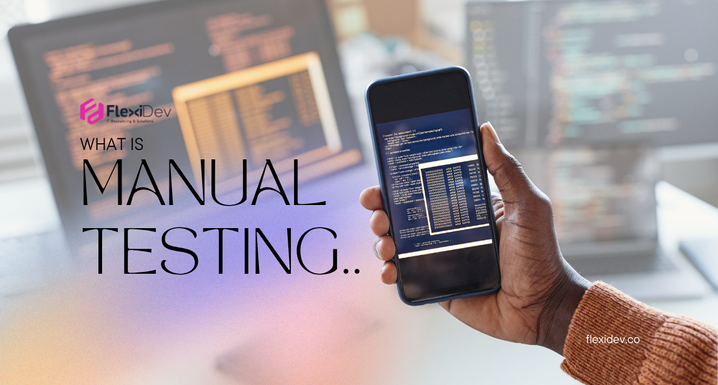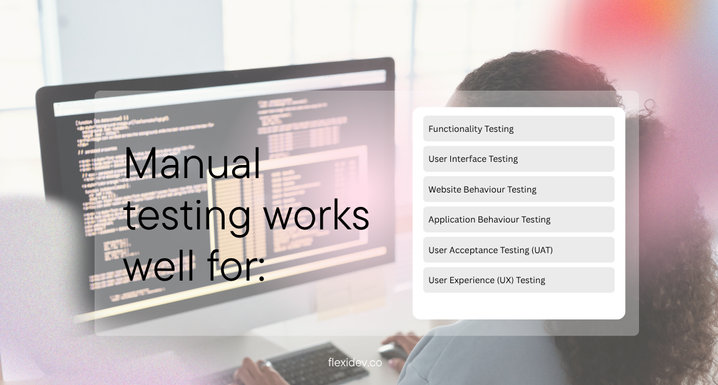
Manual testing is where a Quality Assurance engineer verifies the effectiveness of each aspect of an application, ranging from accurate delivery of required functionality specified by a client to UI/UX intuitiveness for ease of direct consumer adoption. Manual testing is often compared with automation testing. In automation testing, you would code a program to simultaneously test the same set of possibly thousands of scenarios, perhaps tested once every day, to check that nothing has changed and that all is working as expected. However, this process can only run the tests that have been programmed in and is centered on successful functionality. High-performing products are more than only the functionality, which is why we engage manual testing. Manual testing is effective as there is an exploratory element in that it is carried out by actual software engineers who will divert their attention to intercept potential bugs which an automated test code hasn’t been programmed to scan for.
- Your engineer will gauge successful application behaviour with reference to client and consumer expectations. This is done by utilising findings from initial business analysis, client scoping requirements, and their own professional experience of how a finished product behaves.
- Manual testing is conducted first to form a baseline for what optimal performance of a market-ready product should look like, later informing further automation testing. The results from the executed test cases and test reports, following manual testing, can be integrated into automation tools to rerun crucial targeted use case scenarios.
- The process involves close coordination with stakeholders and product owners, giving your business an accurate impression of product readiness before launch. If there is a high correlation between expected performance and actual functionality, then this will suggest a reliable and impactful product when delivered.

When to Perform Manual Testing?
Manual testing is an essential part of the software development process, particularly when human judgment, intuition, and real-time feedback are necessary. While automated testing is effective for repetitive and high-volume tasks, there are specific scenarios where manual testing provides greater value. It is especially useful in areas that require visual evaluation, user interaction, and exploratory insights. Below are some key cases where manual testing is more effective. Manual testing works well for:
- Functionality Testing: a method used to verify that a software application or system meets its specified functional requirements.
- User Interface Testing: UI (User Interface) testing is the process of verifying and validating the appearance, functionality, and user experience of the user interface of an application or website.
- Website Behaviour Testing: the process of analysing how users interact with a website to understand their behaviour and identify areas for improvement.
- Application Behaviour Testing: a type of software testing that evaluates how a software application behaves under different conditions and scenarios.
- User Acceptance Testing (UAT): the final phase of software testing where real users verify that the developed product meets their needs and requirements, ensuring it functions as expected in real-world scenarios.
- User Experience (UX) Testing: the process of evaluating how real users interact with a product or website to identify usability issues and improve the overall experience.
There are many applications of manual testing in software development where it is not just suitable, but essential. Unlike automated testing, which relies on predefined scripts and requires significant setup, manual testing offers a level of flexibility and human insight that can be critical for projects. Here are a few key scenarios where manual testing proves to be the most effective approach. Manual testing should be conducted when:
- Flexibility is required: with manual tests, a Quality Assurance engineer can quickly test and provide fast feedback. They can be easily instructed to research and explore rare edge cases and uncommon errors, which may for some reason be occurring. This is especially useful when you are in the beta testing phase and receiving feedback from actual users.
- Short-term projects: it is not advisable to invest in a labour-intensive setup of automation scripts when working with short-term projects that focus on minor features and a quick turnaround. Manual testing helps to provide accurate and fast feedback as it is less time-consuming to begin with and involves focusing on specific features within a system.
- When testing end-user usability: the discretion and eye for detail of an experienced professional tester helps product owners get a clearer picture of the impact of errors and inconsistencies which could potentially stall product performance at a later point or lead to confusion for your target consumer.
- Additionally, much time in the testing process can involve effectively first identifying where an error is occurring and how it is generated. This requires clear communication and sometimes much ingenuity in trial and error to replicate the same conditions that have produced the issue, so that developers can then as a result go on to find the root cause and resolve.
Benefits of Manual Testing
In today’s fast-paced digital landscape, delivering reliable, secure, and user-ready software is a challenge – and that’s precisely why manual testing is necessary. With a focus on user experience and adaptability, manual testing empowers teams to think critically, catch the unexpected, and respond to real-world conditions that automation might overlook. It’s not just about finding bugs – it’s about understanding your product deeply and shaping it for success.
While manual testing demands some time and thoughtful effort, the payoff is clarity in product delivery, confidence in stable performance, and closer control of development output for stakeholders. When done by skilled testers, it becomes a strategic advantage, detecting subtle issues, responding to soaring user needs, and ensuring your application stands strong under pressure.
Choose manual testing when precision matters. When security is essential. When you’re aiming for excellence, not just completion. It’s not just a process – it’s a mindset, a conversation, and a commitment to delivering nothing less than the best.
Take a closer look. Start the conversation. Discover what our expert software testers can do on your projects. They can be assigned for as long as you need and will accommodate and pivot with the evolving requirements from your own team. Enhance your service today for higher security, more reliable service performance, and greater cost-efficiency. Connect with FlexiDev to find out more.



